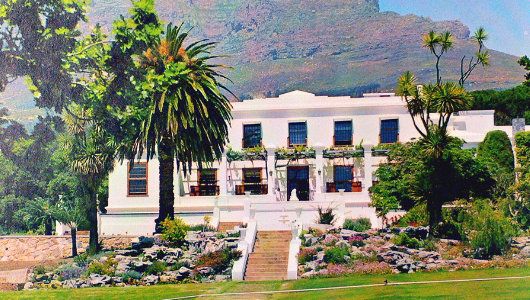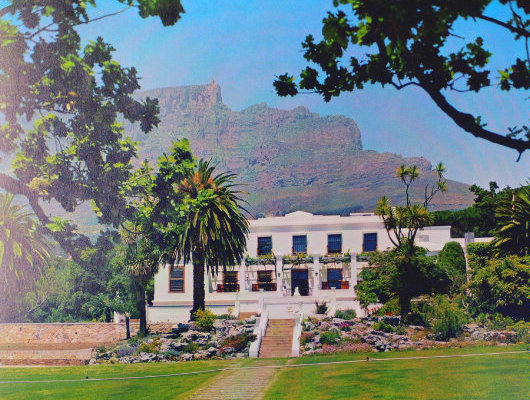
About Andrew Cusack
 Writer, web designer, etc.; born in New York; educated in Argentina, Scotland, and South Africa; now based in London.
Writer, web designer, etc.; born in New York; educated in Argentina, Scotland, and South Africa; now based in London. read more
News
Blogs
Reviews & Periodicals
Arts & Design
World
France
Mitteleuropa
Knickerbockers
Argentina
The Levant
Africa
Cape of Good Hope
Netherlands
Scandinavia
Québec
India
Muscovy
Germany
Academica
Leeuwenhof

One of the better aspects of the job of Premier of the Western Cape is Leeuwenhof, the official residence that comes with the job. The estate on the slopes of Table Mountain dates from the days of the Dutch East India Company. That renowned governor of old, Simon van der Stel (after whom both Simonstad & Stellenbosch are named), granted the land to Guillaum Heems, a free burgher, to ‘clear, plant, plough, develop and work’. Heems christened the land Leeuwenhof — “Lions Court” — but sold it just two years later to Heinrich Bernhard Oldenland, Master Gardener of the Company’s Garden and Superintendent of Works for the Dutch East India Company.
Oldenland died just a few months after purchasing Leeuwenhof, and it passed into the hands of the fiscal Blesius, whose widow’s death put the estate under a series of masters until it was sold it for 14,000 guilders to Johan Christiaan Brasler, a Dane. Brasler enjoyed a good many years there in prosperity of late-eighteenth-century Cape Town, a period when the building of stately homes, townhouses, and government buildings became (as Cornelis de Jong put it at the time) “a passion, a craziness, a contagious madness that has infected nearly everyone”. This was the age of Thibault, Anreith, and Schutte — the true golden age of Cape Town’s stately finery. Inspired by the “madness” of which De Jong tells, the Dane Brasler converted the humble farmhouse of Leeuwenhof into the dignified abode we know today.
Johannes Zorn bought Leeuwenhof in 1799 for 90,000 guilders. Zorn was a military officer who enjoyed great prominence in the social realms of the Cape. (Incidentally, there is a Col. Zorn in the service of the Empire State who is among the Honoured Ranks of Our Favourite People). He eventually retired as landdrost (magistrate) to devote his remaining days to the Leeuwenhof estate, where he died in 1825.
In the nineteenth century, Leeuwenhof found an owner in Christoffel Joseph Brand, whose son Jan became President of the Orange Free State, and then Petrus Johannes Kotzé, twice Mayor of Cape Town and a member of the Cape Parliament. The growth of the city infringed upon the 200-acre estate, and large portions were sold off until the estate shrunk to the five acres that remain. In 1936, the Provincial Administration of the Cape of Good Hope purchased Leeuwenhof and it became the home and office of the Cape Admistrator (as the chief officer of the old province was known).
When the Western Cape province was erected in 1994, it became the official residence of the democratically selected Premier of the Western Cape. For ten years this office was held by members of the National Party until the ANC gained control of the provincial parliament in 2004. In May of this year, the DA took control of the Western Cape legislature, and its leader Helen Zille has since moved into Leeuwenhof with her husband Prof. Johann Maree and their two sons.

Search
Instagram: @andcusack
Click here for my Instagram photos.Most Recent Posts
- Faithful Shepherd of the Falklands April 8, 2025
- Articles of Note: 8 April 2025 April 8, 2025
- Proportionality Destroys Representation April 8, 2025
- Sag Harbor Cinema March 26, 2025
- Teutonic Takeover March 10, 2025
Most Recent Comments
Book Wishlist
Monthly Archives
Categories



A humble ‘master gardener’ buying such a grand pile? Ah… it seems he was ‘Superintendent of Works’ for the DEIC. Perhaps some things have never changed in South Africa.
Can you tell me who was the last owner of leeuwenhof before the Cape provincial Administration bought it?